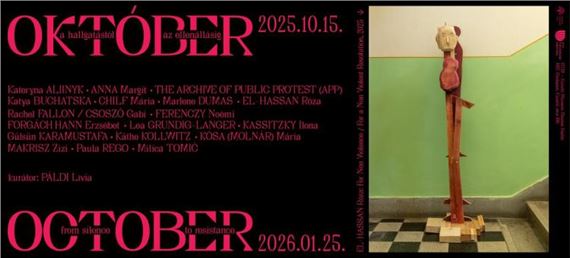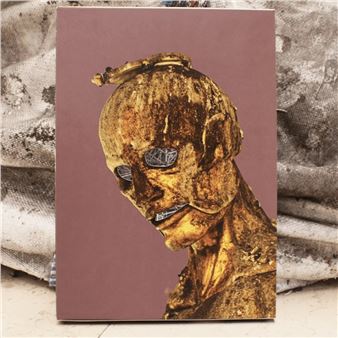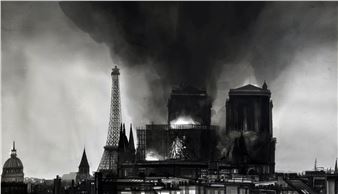October from silence to resistance
Two years ago, at the Budapest Gallery, I curated On Violence, an exhibition that examined systemic and structural violence through its intersectional dimensions. It responded to the urgent need for deeper, more nuanced analyses by incorporating feminist and queer perspectives to investigate the mechanisms of patriarchal dominance embedded in collective culture and political economies. The continuing escalation of violence has compelled more artists to testify to the dire circumstances in which they, along with other cultural workers, sustain creative resistance—often despite attempts at silencing.
OCTOBER continues this trajectory, focusing on the entanglement of the political with the personal and intimate, with particular attention to women’s perspectives. Historical works are placed in dialogue with contemporary positions to foreground these connections.
The constellation of works examines the politicization of the private sphere—how personal experiences and observations, born of cataclysm, yield distinct insights into the impact of violence and the persistence of unhealed collective trauma. The exhibition raises questions of responsibility and individual agency while pointing toward the liberatory potential of artmaking and the forms and spaces of intimacy that can foster solidarity.
Structured as a non-linear “mind map”—elliptical and associative—OCTOBER proposes connections that reflect the perpetuity of political, social, and economic systems of oppression. Texts by Marguerite Duras, Charlotte Delbo, Virginie Despentes, Françoise Vergès, Grupa Spomenik, Ariella Aïsha Azoulay, Fadwa Tuqan, and others played an essential role in shaping OCTOBER and underscore the urgency of learning from historical anti-war and anti-fascist legacies in confronting today’s (post)-fascist ideologies and the reality of “contemporary–permanent–war.”
The narratives interwoven here encompass personal stories, survival journeys, acts of creative resistance, histories of remembrance, and the lasting effects of war—on landscapes and cities, and on bodies as living archives bearing the scars of years marked by atrocities and deprivation.
Here, the personal and the intimate serve as lenses through which broader political and social realities are experienced, examined, and understood. Art emerges as observation and documentation, as a coping mechanism, and as an act of resistance. It becomes a means to confront inequality, expose violations of human rights, and cultivate a dynamic exchange of identities and positions. A radical act of thought. A silent bearing witness. A gesture of empowerment. A fragile, unending exchange between inner lives and shared histories.
In its modest way, OCTOBER also pays tribute to German graphic artist and sculptor Käthe Kollwitz (1867–1945). Her legacy of social advocacy and anti-war resistance resonates profoundly today. Through her etchings and drawings, Kollwitz gave radical, empathetic form to the struggles of the working class and urban poor—especially underprivileged women—enduring hunger, illness, child mortality, and war. Her unwavering commitment to social justice makes her work a powerful point of departure for the exhibition’s inquiry.

Recommended for you
Two years ago, at the Budapest Gallery, I curated On Violence, an exhibition that examined systemic and structural violence through its intersectional dimensions. It responded to the urgent need for deeper, more nuanced analyses by incorporating feminist and queer perspectives to investigate the mechanisms of patriarchal dominance embedded in collective culture and political economies. The continuing escalation of violence has compelled more artists to testify to the dire circumstances in which they, along with other cultural workers, sustain creative resistance—often despite attempts at silencing.
OCTOBER continues this trajectory, focusing on the entanglement of the political with the personal and intimate, with particular attention to women’s perspectives. Historical works are placed in dialogue with contemporary positions to foreground these connections.
The constellation of works examines the politicization of the private sphere—how personal experiences and observations, born of cataclysm, yield distinct insights into the impact of violence and the persistence of unhealed collective trauma. The exhibition raises questions of responsibility and individual agency while pointing toward the liberatory potential of artmaking and the forms and spaces of intimacy that can foster solidarity.
Structured as a non-linear “mind map”—elliptical and associative—OCTOBER proposes connections that reflect the perpetuity of political, social, and economic systems of oppression. Texts by Marguerite Duras, Charlotte Delbo, Virginie Despentes, Françoise Vergès, Grupa Spomenik, Ariella Aïsha Azoulay, Fadwa Tuqan, and others played an essential role in shaping OCTOBER and underscore the urgency of learning from historical anti-war and anti-fascist legacies in confronting today’s (post)-fascist ideologies and the reality of “contemporary–permanent–war.”
The narratives interwoven here encompass personal stories, survival journeys, acts of creative resistance, histories of remembrance, and the lasting effects of war—on landscapes and cities, and on bodies as living archives bearing the scars of years marked by atrocities and deprivation.
Here, the personal and the intimate serve as lenses through which broader political and social realities are experienced, examined, and understood. Art emerges as observation and documentation, as a coping mechanism, and as an act of resistance. It becomes a means to confront inequality, expose violations of human rights, and cultivate a dynamic exchange of identities and positions. A radical act of thought. A silent bearing witness. A gesture of empowerment. A fragile, unending exchange between inner lives and shared histories.
In its modest way, OCTOBER also pays tribute to German graphic artist and sculptor Käthe Kollwitz (1867–1945). Her legacy of social advocacy and anti-war resistance resonates profoundly today. Through her etchings and drawings, Kollwitz gave radical, empathetic form to the struggles of the working class and urban poor—especially underprivileged women—enduring hunger, illness, child mortality, and war. Her unwavering commitment to social justice makes her work a powerful point of departure for the exhibition’s inquiry.
Contact details


 ARTISTS
ARTISTS















